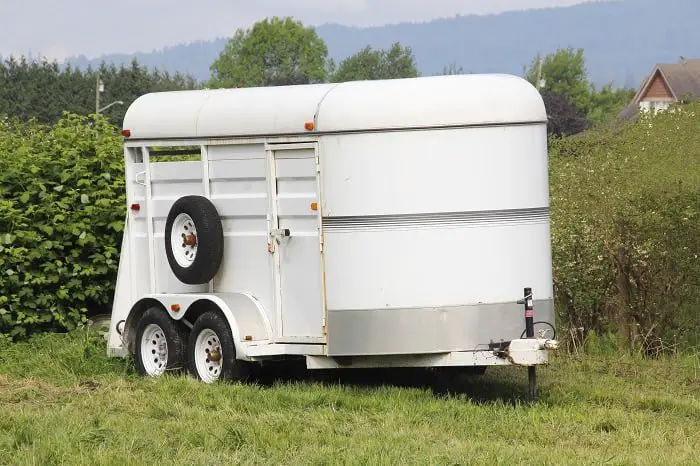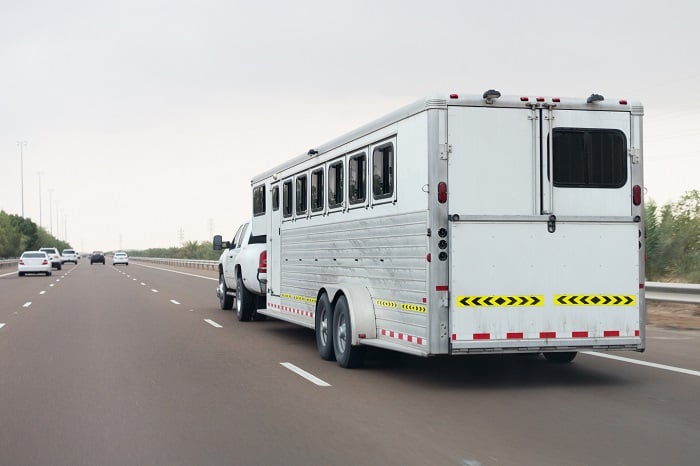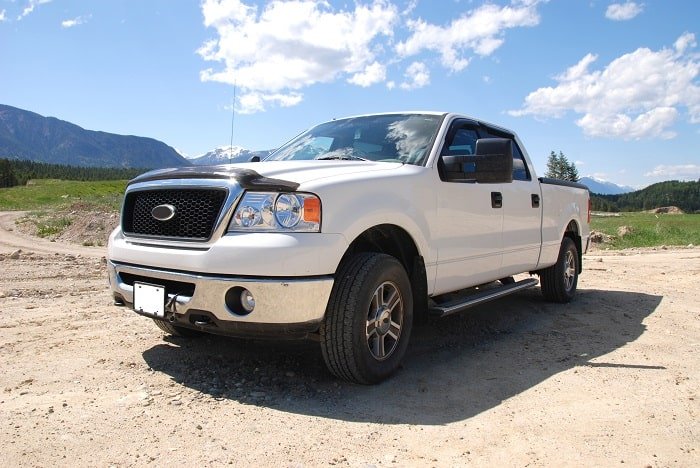Last Updated on March 31, 2023
Every horse owner knows the importance of having the right trailer when hauling a horse. So, how much does a horse trailer weigh?
Safety is the number one priority when hauling a horse, so you must have a trailer that fits your vehicle and horse. One of the key aspects of finding the right trailer is knowing the average weight of horse trailers (2 and 4 horses).
There are many factors to take into consideration when hauling a horse. You need to think about how many horses you will tow at once, how much space you need for equipment, do you need a living space, and how much weight your vehicle can pull, amongst other things.
There are several different types of horse trailers you can buy. There are goosenecks, bumper pulls, stock trailers, and trailers with living quarters. These trailers all vary in size and weight due to the features they have.
How Much Does a Horse Trailer Weigh? Types of Trailers
Bumper pulls
Bumper pull trailers are one of the most common forms of horse trailers. They are designed to be able to be pulled by most SUVs and pick-up trucks. Bumper pull trailers normally have some form of a tack room or storage space.
Bumper pulls are a great choice for first-time trailer owners. They have a normal turn radius and don’t need a special hitch system. Bumper pulls often only have room for two horses.
Goosenecks
So, what’s a gooseneck horse trailer? Goosenecks have a unique design where they attach to a ball hitch in a pick-up truck bed.
Goosenecks are often larger than bumper pulls and can hold more weight. They are often more stable than bumper pulls because of the tongue weight being over the truck’s rear axle versus the back of the frame.
Goosenecks are also easier to turn and maneuver. They have a tight turn radius, making it easier to cut corners and pull into tight spaces. However, it can be tricky to learn how to turn a gooseneck without messing up the trailer’s fender or hitting objects close to you.
Some goosenecks are heavy enough to be considered commercial vehicles. Goosenecks also require a special hitch setup in the bed of a pick-up truck that needs to be installed, as most trucks don’t come equipped with them.
Trailers with living quarters
Certain trailers also come with living quarters for people. They usually include a bed, bathroom, kitchen, and small living area. They are a popular choice for those who show, as many show facilities have trailer hookups available. This allows you to be on-site at the facility your horse is staying at.
Goosenecks are the most common type of trailers with living quarters. Most trailers with living quarters are four-horse trailers.
Stock trailers
Stock trailers are the most basic form of horse trailers. They are often made from steel or aluminum and are the most budget-friendly trailers. They can be bumper pulls or goosenecks. Stock trailers can be either two or four-horse.
Stock trailers often have no additional room or just a small storage area. They are known for being heavy-duty and reliable.
Gross Vehicle Weight Rating
The gross vehicle weight rating (GVWR) is the weight limit for your vehicle set by the manufacturer. Most cars have a sticker with their GVWR. The GVWR weight includes the weight of passengers, equipment, cargo, and tongue weight.
It is very important to follow your vehicle’s GVWR. If you surpassed your vehicle’s GVWR, you are risking your brakes giving out, tires blowing out and the suspension failing.
Horse trailers also have a GVWR. A trailer’s GVWR is commonly found on a sticker inside one of the doors. You need to take your vehicle and trailer’s GVWR into account when traveling.
Vehicle’s towing capacity
When going to purchase a trailer, you need to find out your vehicle’s GVWR. If you have a large pick-up truck, such as a Ford F-450, it will have a towing capacity of around 21,000 pounds or up to 34,000 pounds with a gooseneck. A large SUV, such as a GMC Yukon, can pull up to 8,500 pounds.
How Much Does a Horse Trailer Weigh?
The most common type of two-horse trailer is a bumper pull that has a small storage space. A two-horse bumper pulls generally weighs 3,200 pounds. This includes spots for two horses and a small tack room that can also be used as a dressing room.
The average weight of a gooseneck four-horse trailer is 6,300 pounds. Most four-horse trailers are goosenecks, as a trailer this size is easier to tow as a gooseneck. They also often have a small tack room that can double as a dressing room.
-
4-star horse trailer weight
4-Star is a popular brand of horse trailers in America. All of their horse trailers are hand-crafted in Oklahoma City, Oklahoma.
4-Star offers gooseneck and bumper pull trailers in the following categories: Horse, Stock/Combo, Stock, Polo, and Cargo/Car Hauler. Trailer models are sold in two base model platforms: Deluxe and Runabout.
4-Star offers a wide variety of trailers and features to meet your needs. From two-horse bumper pulls to 7-horse goosenecks, they have you covered. Trailers can be customized as well to include all of the features you would like.
Since 4-Star trailers can vary widely by the features added, they do not include the weight of their trailers on their website. However, their 2-horse straight and slant runabout trailers have a maximum axle capacity of 7,000 pounds.
4-Horse trailer weight with horses
When you take into account four horses, tack, equipment, clothes, hay, and grain, the weight total will be an average of 10,700 pounds. For four-horse trailers with living quarters, the weight of just the trailer will be closer to an average of 7,900 pounds.
-
Featherlite 2-horse trailer weight
Featherlite trailers are one of the most popular brands of trailers. They are designed to be practical for horse owners from all walks of life.
Featherlite offers a variety of different horse trailers from bumper pulls to goosenecks. They offer several different features including living quarters to meet all of your needs.
Featherlite trailers are designed to be lightweight and safe while also being practical for both horses and people. They even have the option to customize their horse trailers as well.
There are a few different models of Featherlite 2-horse trailers. The 2-horse bumper pull model 9652 weighs 2,7000 pounds. The 2-horse bumper pulls model 9551 ranges in weight from 3,400 to 5,200 pounds depending on the features included.
For the 2-horse bumper pull model 9651, it weighs 2,700 for 0r 3,200 pounds depending on which version you choose. The 2-horse gooseneck model 9607 weighs 3,300 pounds. The 2-horse gooseneck model 8541 weighs between 4,250 pounds to 5,200 pounds depending on the features.
2-Horse trailer weight with horses
It is important to take into consideration how much your horses and equipment will weigh. Once you add two horses, approximately 1,000 pounds each, hay, grain, tack, clothes, and equipment, you will likely exceed 5,600 pounds.
-
Circle J horse trailer weight
Circle J is another popular horse trailer manufacturer in America. While they are currently not producing new trailers, it is common to find used Circle J trailers for sale.
Depending on the model, Circle J trailers typically weigh between 3,100 pounds to 7,500 pounds. Circle J made different styles of trailers including bumper pull and gooseneck.
-
Kingston 2-horse trailer weight
Kingston is another well-established horse trailer manufacturer. Their trailers are custom hand-built with all aluminum.
The Classic Standard 2-Horse by Kingston is a bumper pull trailer that weighs 2,100 pounds. The Endurance 2-Horse with Dressing Room bumper pull trailer weighs 3,000 pounds. Their other 2-horse bumper pull trailers range in weight from 2,300 to 3,500 pounds.
The Belvedere Classic 2-Horse with Dressing Room gooseneck trailer weighs 3,900 pounds. Their other gooseneck option, the Brunswick Classic Elite 2-Horse Side Unload with Dressing Room, weighs 4,500 pounds.
-
Sundowner Valuelite trailer weight
Sundowner is another prominent trailer company for horse trailers. The Sundowner Valuelite trailer was one of the most popular models made for several years that can still be bought used.
The Sundowner Valuelite trailer typically weighs around 15,000 pounds. However, the exact weight can vary by the features included in the trailer.
This helpful video will give you a better understanding of towing concerns and trailer tips.
How Much Does a Horse Trailer Weigh? Finding the Right Horse Trailer for You
If you are looking to get a horse trailer, there are some things you need to take into consideration. You need to consider how much your vehicle can tow, how many horses you will tow, do you need storage space and do you want living quarters.
Please comment if you enjoyed this article or have any remarks regarding this post! Also, see the following article to learn about the best ways to lock a trailer.
Though it depends on the type of trailer and the feature it has, you can find the average weight of two and four-horse trailers based on the most common models:
- The most common model of a two-horse trailer is a bumper pull that includes storage space, weighing an average of 3,200 pounds empty.
- The most common model of a four-horse trailer is a gooseneck with storage space, weighing an average of 6,300 pounds empty.
FAQs
How much towing capacity do I need to tow a horse trailer?
Horse trailers come in a variety of weights, lengths and types. You should be able to tow a horse trailer with the right towing capacity for your car.
The maximum towing capacity for a semi-trailer is 12,500 pounds. While the maximum for a full-sized pickup truck is 9,000 pounds. In order to know what you can tow with your vehicle, you will need to pay attention to your type of vehicle and the gross weight that it can hold when it's empty.
If you are planning on transporting more than one horse or supplies then you will need more than one trailer or bigger trailer that can accommodate the weight of everything that you want to bring with you.
The best way to figure out your towing capacity is by using this equation:
Towing Capacity = (Weight of Trailer) x (Gross Vehicle Weight Rating) / (Gross Axle Weight Rating)
The Gross Vehicle Weight Rating is found on the driver's door of your vehicle.
Weight is one of the most important factors in towing capacity. It is important to remember that this number does not take into account braking or acceleration capabilities. Your trailer weight must be under the tow vehicle's gross vehicle weight rating. If you are towing up a steep hill, you might need to downshift in order for the car engine not to overheat and for your brakes not to fail.
What is the most durable horse trailer?
In recent years, horse trailers have been given a makeover. The trend that has been catching on is the desire for a trailer that can handle todays’s rugged trail rides. Manufacturers are now building trailers with better suspension and ground clearance to take on the challenges of today's terrain. For those who still think a horse trailer is an old-fashioned idea, there are a wide range of models available to suit every budget and skill level.
The durability of a horse trailer is integral to ensuring your horses stay safe on the road. If you are looking for one of the most durable trailers on the market today, consider these five top brands: Big Tex Trailers, Featherlite Trailers, Dura Horse Trailers, Timpte Manufacturing Company and Western Horseman Trail.
When debating which type of trailer to buy one also needs to consider what materials they are made of. The lighter aluminum trailers are beneficial because they use less fuel and produce less exhaust, but are not that durable. Steel is heavier but can last for decades and is more durable in all weather conditions.
Keep in mind that durable, high quality trailers should be able to handle any type of terrain without having to worry about the trailer getting severely damaged or compromising the safety of your animals.
What is an average price for a standard 2 horse trailer?
Horse trailers come in a variety of sizes and styles and they can be more expensive depending on what they offer. For example a basic two-horse trailer would cost around $7,000-$9,000 while a luxury trailer that includes air conditioning would cost around $25,000-$30,000.
The cost difference may seem shocking but it is important to consider what you will be using the trailer for and how often you will need it.
Michael Dehaan is a passionate horse owner, horse rider, and lover of all things equine. He has been around horses since he was a child, and has grown to become an expert in the field. He has owned and ridden a variety of horses of different breeds, and has trained many to compete in shows and competitions. He is an experienced horseman, having worked with and competed many horses, including his own. He is an active member of the equestrian community, participating in events and teaching riding lessons.



